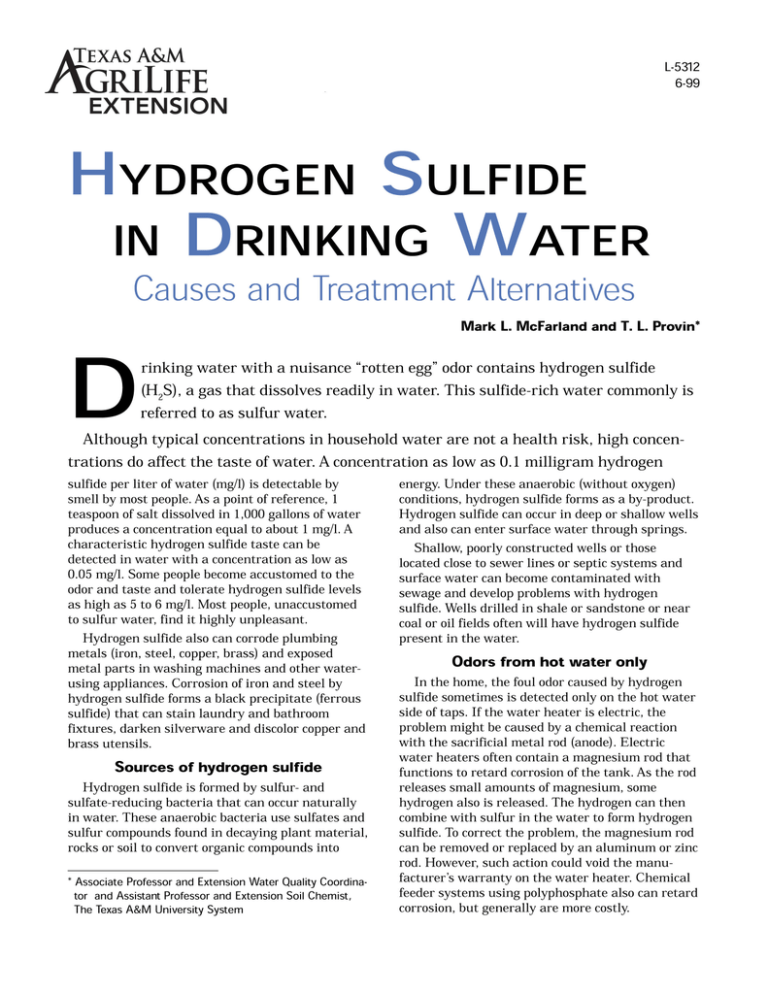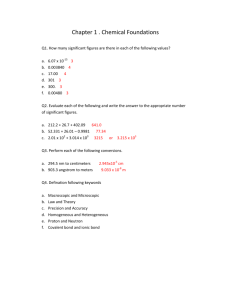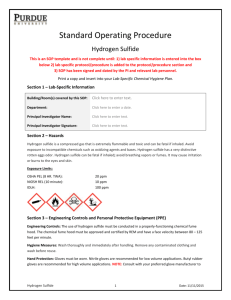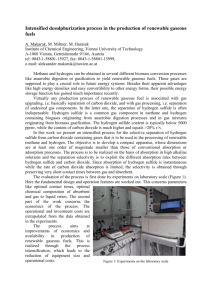Document 10321110
advertisement

Sometimes hot water will have a “sour” smell, similar to that of an old damp rag. This smell often develops when the thermostat has been lowered to save energy or reduce the potential for scalding. Odor-causing bacteria live and thrive in warm water and can infest the water heater. The problem frequently can be corrected by returning the thermostat to its recommended operating temperature (approximately 160 degrees F) for 8 hours. This will kill the bacteria. (Caution: Be sure the water heater has an operable pressure relief valve before increasing the temperature, and warn occupants of the scalding hazard.) If a lower temperature is preferred for routine operation, periodic high temperature flushing can be used whenever the odor returns. bacteria. If the bacteria are detected, treatment to control the bacteria should eliminate the problem. Other contaminants (sulfate, organic compounds and metals) can cause taste and odor problems in drinking water. Water tests should always be conducted on new wells or when problems are suspected in an existing water supply. This can be particularly important if more than one contaminant is involved because it will affect proper diagnosis of the problem and selection of the most effective and economical water treatment system. Treatment options for hydrogen sulfide The recommended treatment to remove hydrogen sulfide from a water supply depends largely on the gas concentration. Testing for hydrogen sulfide The cause of the hydrogen sulfide problem must be determined before proper testing and appropriate treatment can be applied. If the problem is caused by hydrogen sulfide in the groundwater, then the concentration of the gas in the water must be measured in order to select and properly size a treatment system. Hydrogen sulfide gas dissolves readily in water and can readily escape from it (volatilize). Thus, water samples must be tested onsite, or immediately stabilized for laboratory analysis. Sample bottles with stabilizing chemicals should Faucet Mount be obtained from the laboratory that does the analysis. Careful sampling according Filter to laboratory recommendations is critical to ensure accurate and reliable results. In general, the requirements will involve delivery of a Hot refrigerated sample within Cold 48 hours of collection. Sulfide concentrations are reported by laboratories in units of milligrams per liter (mg/l) or parts per million (ppm). Line Bypass These two terms are used interchangeably. If the gas is being produced by an active colony of sulfur-reducing bacteria, this must be determined. Active colonies could be located anywhere within the plumbing system, well casing or in the aquifer. Selected commercial water testing laboratories can determine the presence of sulfur-reducing Trace amounts of hydrogen sulfide (0.05 - 0.3 mg/l) Activated carbon adsorbs soluble organic compounds and certain gases, such as chlorine and hydrogen sulfide, that contribute tastes and odors to a water supply. Very small amounts of hydrogen sulfide can be removed from water with activated carbon filters (Fig.1). Activated carbon is used as a granular form in tank-type filters and as finely divided powder in a cartridge. The hydrogen sulfide is adsorbed onto the surface of the carbon particles. In-Line Hot Cold Filter Point-of-Entry (POE) Nonhousehold Plumbing To Household Plumbing Hot Cold Filter Water Meter Filter Figure 1. Point-of-use and point-of-entry placements of activated carbon filters. 2 Some filters will improve taste, but will not eliminate unpleasant odors. A granular filter must be backwashed periodically; a cartridge filter must be cleaned or replaced periodically. Cleaning frequency depends on the amount of hydrogen sulfide in the water and the volume of water treated. Moderate to high levels of hydrogen sulfide will require frequent filter replacement. These filters also can remove tannins and other dissolved organic compounds. Less than 2 mg/l hydrogen sulfide Aeration (adding air to the water) is a treatment option for this concentration range, and is commonly used by city water treatment systems. Oxygen in the air reacts with hydrogen sulfide to form an odorless, dissolved form of sulfur called sulfate. Several types of aeration systems are available. In one type, compressed air is injected into the water system. The air then must be removed from the water to prevent knocking or air-blocks in the system and to reduce the corrosion potential caused by dissolved oxygen. In another type, water is sprayed into a nonpressurized storage tank (Fig. 2). A second pump is needed to re-pressurize the water. The storage tank provides 6 to 8 hours holding time for oxidation of hydrogen sulfide, iron and manganese. The storage tank and aerator must remain secure to prevent contamination of the water supply, or the system must be chlorinated. This process usually produces a strong hydrogen sulfide odor near the aerator, and may not always reduce the hydrogen sulfide to nondetectable levels. In such cases, a carbon filter can be used to remove some of the remaining trace amounts of hydrogen sulfide. These complex systems are not recommended for household use. Well Pressure Tank Up to 10 mg/l hydrogen sulfide An iron removal filter containing manganese greensand can remove low to moderate levels of hydrogen sulfide in addition to iron and manganese. The process oxidizes hydrogen sulfide into sulfate; iron and manganese form precipitates that are filtered out (Fig. 3). Manganese greensand filters must be recharged with a solution of potassium permanganate when the oxygen is depleted. This process is very similar to the regeneration process used in water softeners, and must be performed at regular intervals of 1 to 4 weeks depending on the chemical composition of the water, size of the unit and amount of water processed. Water with a pH below 6.7 could require acid neutralization, increasing the pH to 7.5 to 8.3, before iron removal will be effective. These filter systems are very specialized and the installation and operation instructions of the manufacturer should be followed precisely. From Well To House Regeneration Unit Manganese Treated Greensand KMnO4 Feed Tank KMnO4 Solution Gravel Filter Figure 3. Manganese greensand pressure filtration system for removal of hydrogen sulfide, iron and manganese. Aerator/Degasifer Check Valve Gate/Ball Valve Well Pump Second Pump To Well Figure 2. Nonpressurized aeration system from hydrogen sulfide removal. 3 Second Pressure Tank Product Water Pressure Tank Check Valve Well Chlorinator Pump Pipe Coil Chlorine Solution Figure 4. Chlorine injection system for removal of hydrogen sulfide. Up to 75 mg/l hydrogen sulfide Continuous chlorination using an automatic chemical feed pump can effectively remove medium to high levels of hydrogen sulfide (Fig. 4). Chlorine quickly oxidizes hydrogen sulfide into a tasteless, odorless form. Continuous chlorination also effectively removes iron and manganese that can occur in association with hydrogen sulfide. Chlorine demand (concentration) and contact time are very important to successful chlorination. The amount of chlorine needed to react with organic and inorganic materials in the water can range from 1 mg/l to more than 10 mg/l if the water is high in sulfide, ammonia, iron or manganese. Table 1 presents typical dosages required to treat specific problems. Contact time (exposure) depends on the concentration of chlorine in the water, water temperature and pH. Oxidation of iron and hydrogen sulfide is instantaneous, while manganese oxidizes more slowly. Chlorine should be introduced into the system before it reaches the storage tank. The tank must have sufficient volume to provide a 20-minute contact time between the water and the chemical. In addition, a fine-retention sediment filter can be used to remove any oxidized iron and manganese. Excess free chlorine is undesirable and can produce an objectionable taste in the water. An activated carbon filter can be used to obtain chlorine-free water for cooking and drinking. Table 1. Approximate Chlorine Dosage for Oxidation of Selected Minerals Based on Concentration (mg/l). Manganese 1.3 times Mn concentration (mg/l) Iron 0.64 times Fe concentration (mg/l) Hydrogen Sulfide 2.2 times H2S concentration (mg/l) single high dose of chlorine placed in direct contact with water and the plumbing system. Chlorine, if used in sufficient concentration and with adequate contact time, is an excellent disinfectant that kills most disease-causing bacteria, viruses and cysts of protozoans. It also kills nonpathogenic iron, manganese and sulfur bacteria. In some cases, iron and sulfur bacteria are more resistant to chlorine because they occur in thick layers and are protected by a slimy secretion. If problems with hydrogen sulfide persist after two attempts at shock chlorination, continuous chlorination could be required. Concentrations of chlorine used in shock chlorination are 100 to 400 times the amount found in treated “city water.” The amount of chlorine needed is determined by the amount of water standing in the well. Table 2 lists the amount of ordinary household bleach (5.25 percent hypochlorite) needed for shock chlorination based on casing diameter and water depth in the well. If the depth of the water in the well is unknown, use a volume of bleach equal to two times the 150-foot depth for the appropriate casing diameter. For example, an 8inch casing diameter with unknown water depth would require 3 gallons of household bleach. Do not use bleach in excess of the recommended amount because it is not necessary and will require additional flushing before household use. Controlling hydrogen sulfide bacteria in wells Shock chlorination can effectively eliminate hydrogen sulfide when the problem is caused by the presence of sulfate- and sulfur-reducing bacteria in the plumbing system. Shock chlorination uses a 4 Table 2. Amount of chlorine needed for shock chlorination. Depth of water in well Casing diameter 4-inch 6-inch 8-inch 10-inch 12-inch 10 feet 25 feet 50 feet 100 feet 1/2 cup 1 cup 1 pint 1 quart 1 1 1 2 1.5 cups 2 pints 2 quarts 1 gallon 1 pint 3 pints 3 quarts 1.5 gallons 2 pints 4.5 pints 1gallon 2 gallons 150 feet 3 pints 3 quarts 1.5 gallons 2 gallons 3 gallons cup pint quart quarts The procedure for treatment is as follows: 1. Dilute the bleach with water in a 5-gallon bucket. This increases the volume. Pour the solution around the sides of the well casing. 2. Connect a garden hose to a nearby faucet and wash down the inside of the well. 3. Do not operate the water system for 2 hours. 4. Next, open each faucet one by one and allow water to run until a strong odor of chlorine is detected. If the odor is not detected, check the rate from Table 2 and add more chlorine to the well, repeating steps one through three. 5. Do not operate the water system for at least 12 to 24 hours. 6. Next, flush the system of remaining chlorine. Begin by turning on outside faucets and letting the water run until the chlorine smell dissipates. Let the water run on the ground to reduce the load on your septic system. High loads of chlorine in the septic tank can kill beneficial bacteria and require re-inoculation of the septic system. Also, do not apply water with high chlorine levels to lawns, gardens or other sensitive plants because injury can occur. 7. Finally, turn on the indoor faucets until the system is completely flushed. Summary Hydrogen sulfide in drinking water is a common nuisance contaminant. Although it is generally not a health hazard, the offensive odor and corrosivity of water containing hydrogen sulfide usually make treatment necessary. Various treatment alternatives exist; however, chlorination is the most common and effective method. Iron and manganese frequently occur in association with hydrogen sulfide, and chlorination is an effective treatment for removing all three of these nuisance contaminants. Table 3 presents a summary of treatment options with estimated cost ranges and associated benefits. Always compare installation and maintenance costs and efficiencies of appropriate treatment alternatives and use qualified professionals for installation and service. Table 3. Treatment options for removal of hydrogen sulfide.* Treatment Type Cost Treatment Range Disposable carbon cartridge Air purge systems $25-100 +$600 <1 ppm <20 ppm Oxidizing carbon filter $800-1,200 <2-4 ppm Greensand/Potassium Permanganate $1,200-1,400 <10 ppm Chlorination systems $900-1,800 <75 ppm Comments Requires regular replacement. Requires sizeable equipment placed away from residence. Chlorination of water could be required in some cases. Not recommended for hard water. Can be used in conjunction systems with chlorination systems to remove all hydrogen sulfide greater than 2 ppm in water. System requires regeneration of oxidizing media. Chemicals can be messy and unpleasant. Upper cost range assumes removal of chlorine using a carbon filter system. *(Based on informal survey of water treatment/equipment suppliers in November 1998) 5





